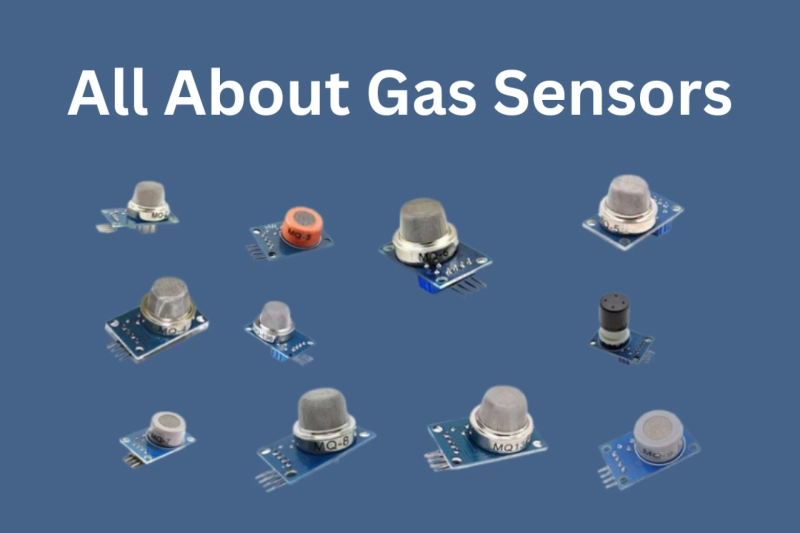Introduction
Gas sensors play a crucial role in detecting and measuring gases in various environments, ensuring safety, efficiency, and automation across industries. In this blog, we provide a complete overview of gas sensors, covering their types, working principles, and applications in fields like air quality monitoring, industrial safety, medical devices, and smart homes.
What is Gas Sensor?
Electronic devices that detect and identify various gas kinds are called gas sensors, or gas detectors. Measurements of gas concentration and the detection of dangerous or explosive gases are common uses for them. In addition to detecting carbon monoxide and smoke in houses, gas sensors are used in factories and manufacturing facilities to detect gas leaks. The range, sensing capability, and size (portable and stationary) of gas sensors vary greatly. They typically have an interface or an audible alert and are a part of a larger embedded system, such hazmat and security systems. These sensors require more frequent calibration than many other kinds of sensors because they are in constant contact with air and other gases.
The physical characteristics and sensing mechanism of sensors might differ significantly depending on their intended settings and purposes. Metal oxide-based gas sensors are among the most widely used gas sensors for smoke and hazardous identification. A chemiresistor, which comes into touch with and interacts with target gases, is used in this kind of sensor. When metal oxide gas sensors come into contact with gases including butane, hydrogen, carbon monoxide, and methane, their electrical resistance increases. Oxide-based sensors are used in the majority of residential smoke detection systems.
Types of Gas Sensors
Gas sensors are used to detect and measure different gases in the environment. They are widely used in industrial safety, environmental monitoring, and home automation. Here are the main types:
1. Electrochemical Gas Sensors
How It Works: Measures gas concentration through chemical reactions that produce an electrical current.
Examples:
-O₂ (Oxygen) sensor
-H₂S (Hydrogen Sulfide) sensor
Applications: Gas leak detection, industrial safety, air quality monitoring.
2. Infrared (NDIR) Gas Sensors
How It Works: Uses infrared light absorption to detect gases.
Examples:
-CO₂ (Carbon Dioxide) sensor
-CH₄ (Methane) sensor
Applications: HVAC systems, air quality monitoring, industrial process control.
3. Semiconductor Gas Sensors (Metal Oxide Sensors - MOS)
How It Works: Measures changes in electrical resistance when gases react with a semiconductor surface.
Examples:
-MQ-2 (Methane, Propane, and LPG)
-MQ-3 (Alcohol sensor)
-MQ-7 (Carbon Monoxide sensor)
Applications: Fire detection, breath analyzers, air quality monitors.
4. Catalytic Gas Sensors
How It Works: Oxidation of flammable gases produces heat, changing resistance.
Examples:
-LEL (Lower Explosive Limit) sensors
Applications: Detecting combustible gases like methane, propane, and hydrogen.
5. Photoionization Detectors (PID)
How It Works: Uses UV light to ionize gas molecules and measure their concentration.
Examples:
-VOC (Volatile Organic Compound) sensors
Applications: Industrial safety, environmental monitoring.
6. Acoustic Gas Sensors
How It Works: Detects sound wave changes when gas concentration varies.
Examples:
-CH₄ (Methane) sensors in underground mines
Applications: Natural gas leak detection, underground safety.
Each type of gas sensor is designed for specific applications based on sensitivity, accuracy, and environmental conditions.
Working Principle of Gas Sensors
Gas sensors are made to identify and quantify the gases present in a given area. Depending on the kind of gas being detected, they function according to distinct principles. Electrochemical sensors are perfect for detecting harmful gases like hydrogen sulfide and carbon monoxide because they use a chemical reaction to produce an electrical current proportionate to the gas concentration. Infrared sensors, which are frequently used to detect gases like carbon dioxide and methane, evaluate gas levels by examining the absorption of infrared light. Semiconductor (metal oxide) sensors can detect flammable gases like alcohol and propane because they alter electrical resistance when gases interact with a heated metal oxide surface.
Photoionization detectors (PID), which ionize gas molecules and monitor volatile organic compounds (VOCs) in industrial settings using ultraviolet (UV) light, are another example of an advanced gas sensing technology. Acoustic gas sensors, which are frequently used to detect subsurface gas leaks, employ differences in sound wave propagation to identify changes in gas concentration. These sensors are essential for industrial automation, safety, and environmental monitoring since they reduce risks and enhance air quality. Modern gas sensors are becoming more effective with the incorporation of IoT technology, enabling real-time data monitoring and alarms for improved safety and clever applications.
Uses of Gas Sensors
Industrial Safety: In mines, refineries, and factories, look for dangerous gasses including hydrogen sulfide, carbon monoxide, and methane.
Fire Detection: To avoid any fire threats, detect flammable gasses.
Automobile Industry: Keep an eye on vehicle exhaust emissions to guarantee engine efficiency and environmental compliance.
Environmental Monitoring: Keep tabs on greenhouse gasses like CO2 and NOx as well as air pollution.
Medical Applications: In breathalyzers used to diagnose diseases like diabetes and asthma.
IoT and smart homes: track indoor air quality, activate ventilation systems, and find gas leaks.
Agriculture: To improve farming conditions, measure ammonia levels and greenhouse gas emissions.
Food Industry: Use CO2 and ethylene detection to ensure the safety of food storage.
Military & Defense: Recognize harmful gasses in situations involving chemical warfare.
Research & Development: Utilized in laboratories for experimental and gas analysis
Conclusion
Gas sensors are vital equipment for preserving environmental protection, improving industrial and residential applications, and ensuring safety. These sensors are work with Arduino and Raspberry Pi and are essential to contemporary automation and smart systems, helping to identify harmful gasses in factories, monitor air pollution, and even guarantee the safety of food. With continuous advancements in sensor technology, their accuracy, efficiency, and integration with IoT devices are improving, making them indispensable in various sectors. Gas sensors will continue to be an essential part of technology advancement as long as businesses and homes place a high priority on environmental health and safety. In India, Robocraze provides the best quality high accuracy Gas sensors at lowest price with COD, easy return, and tech support options.


